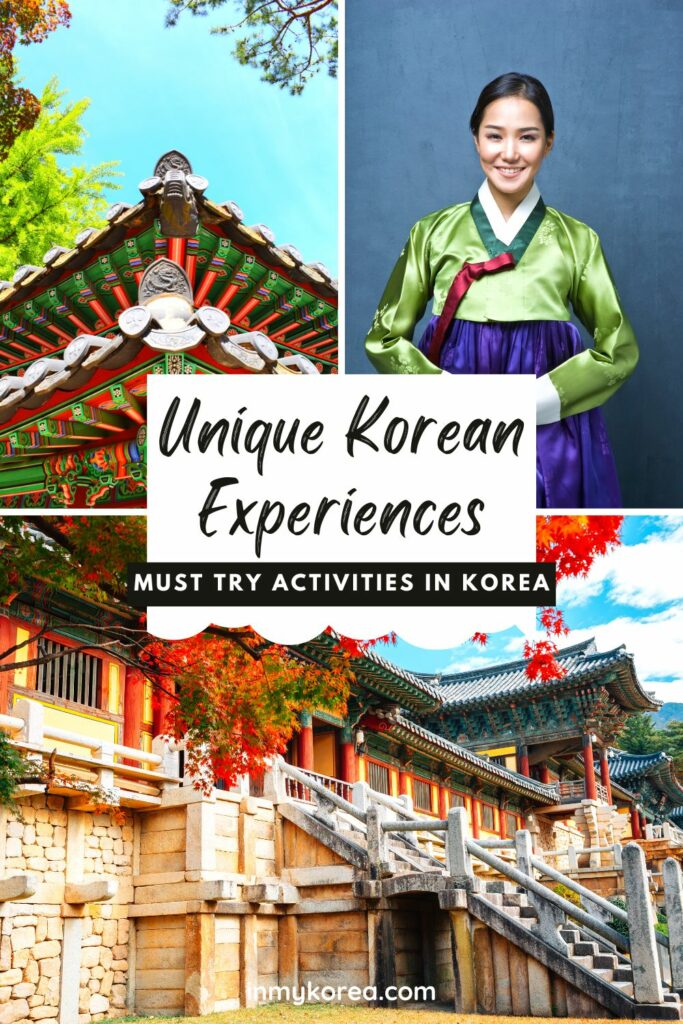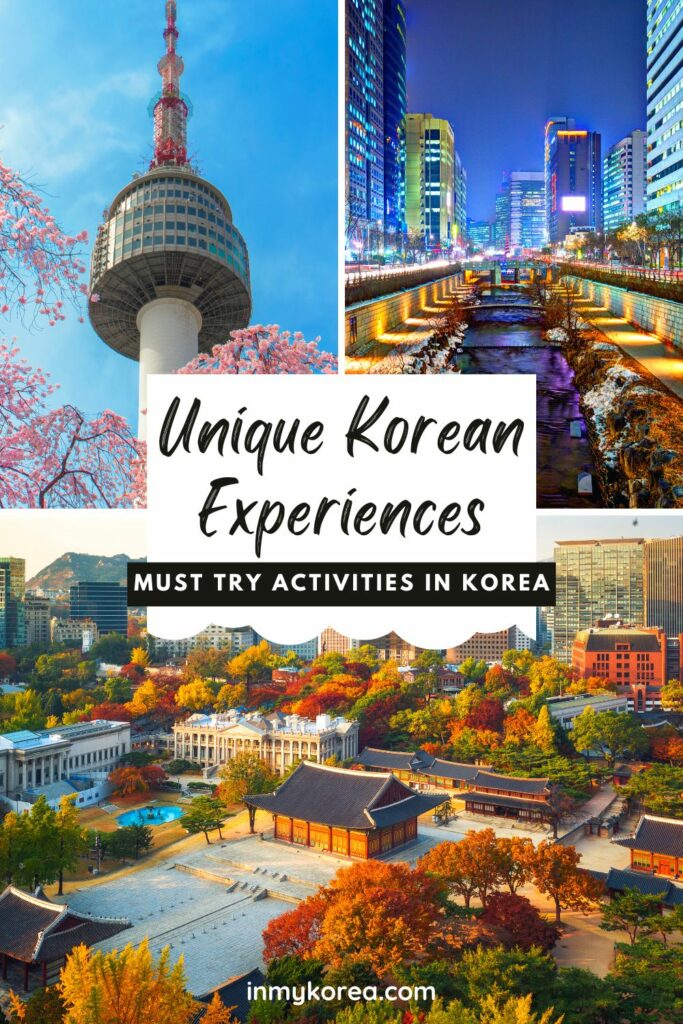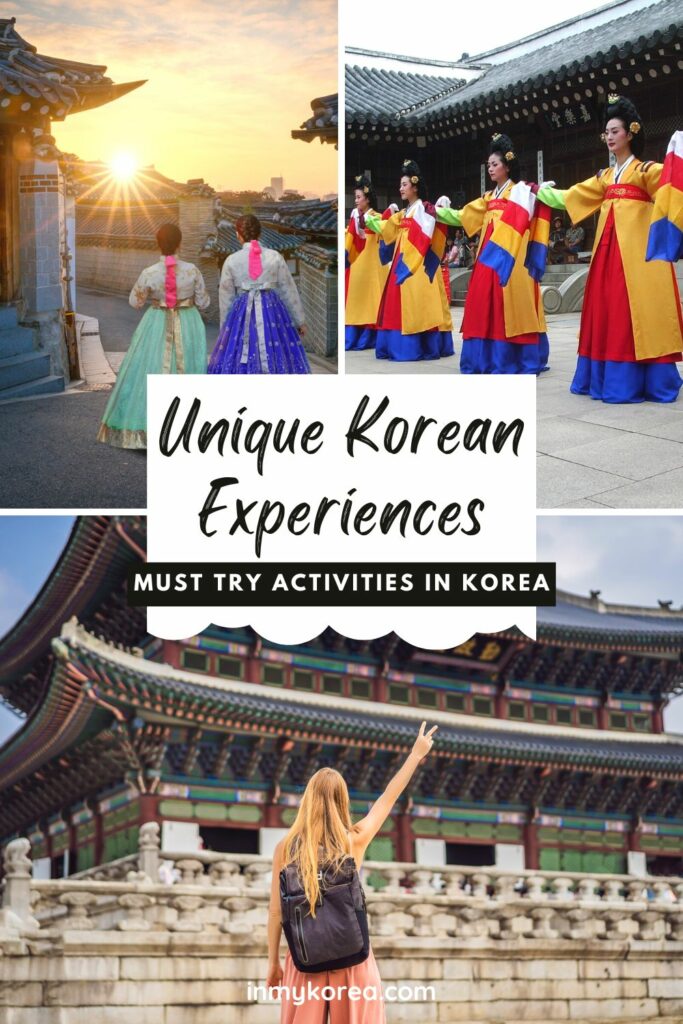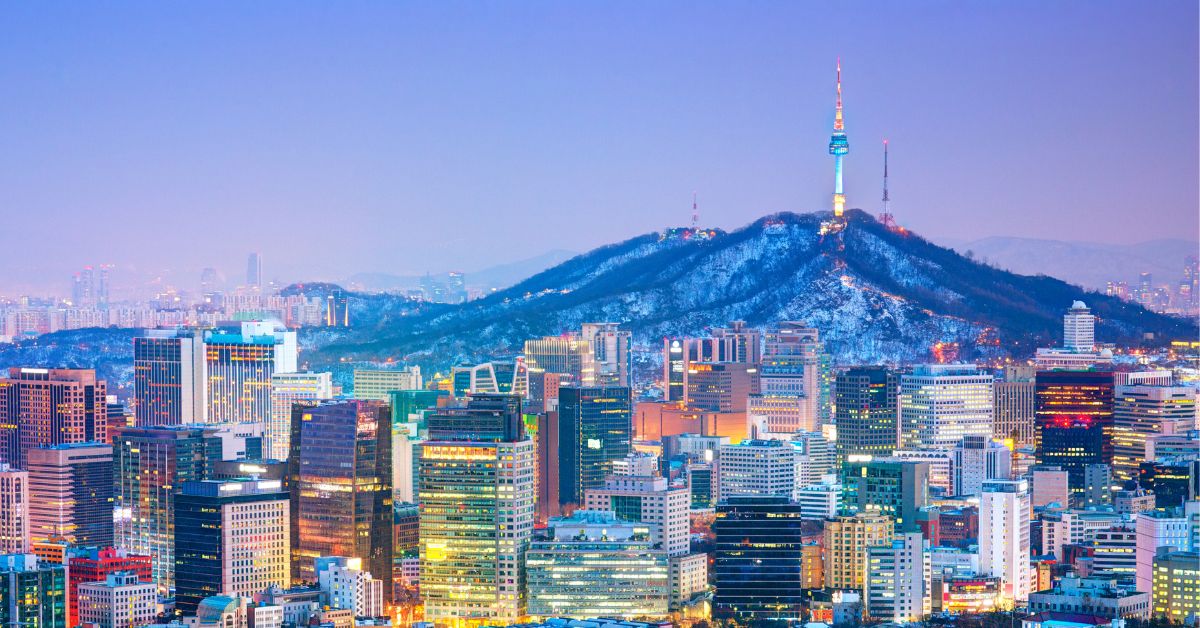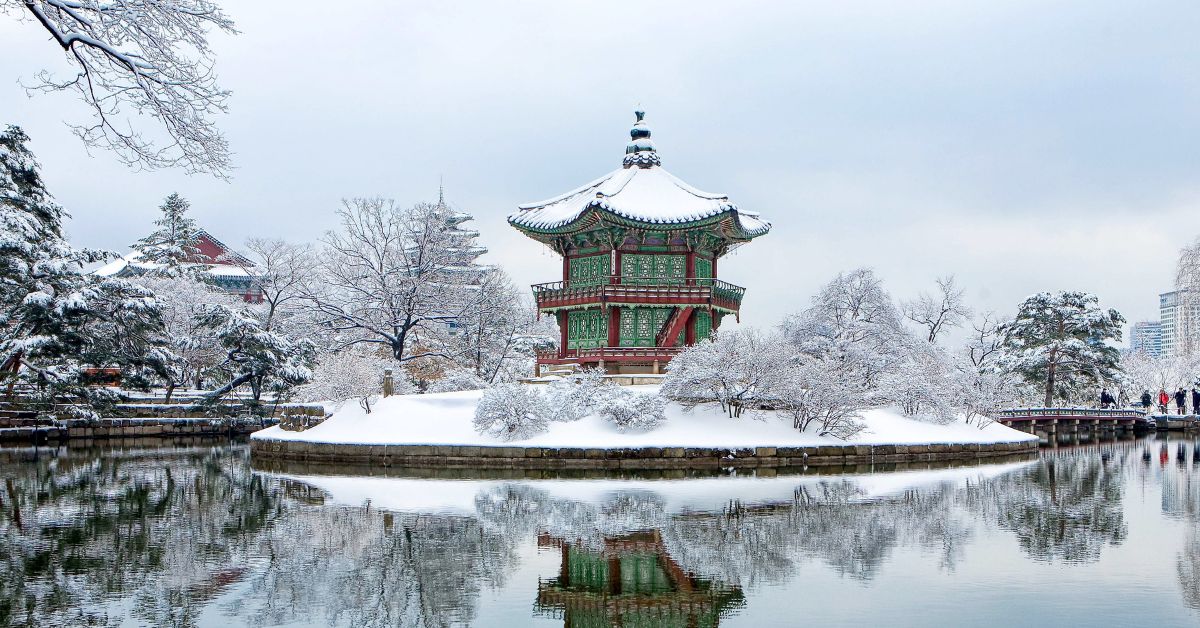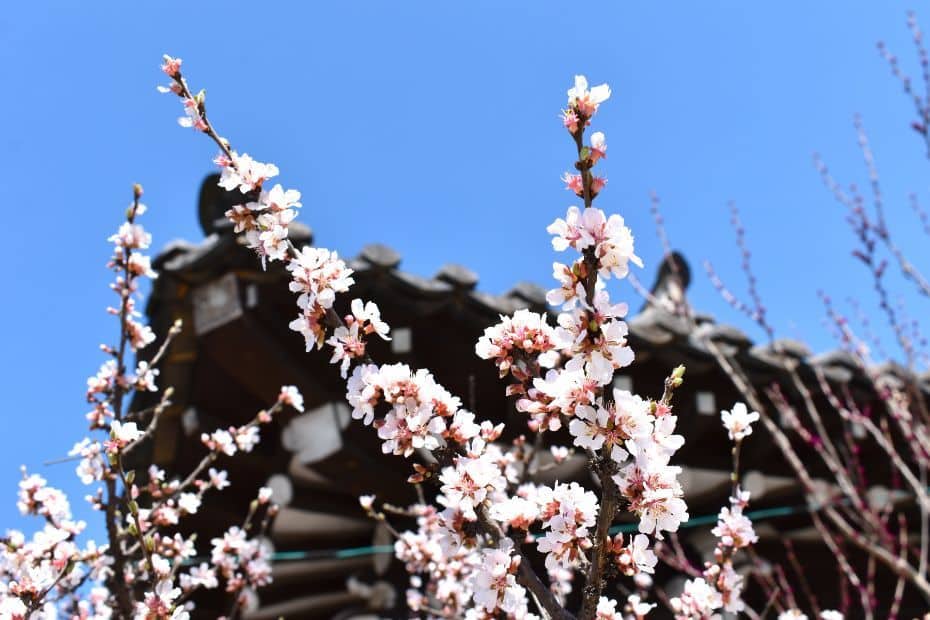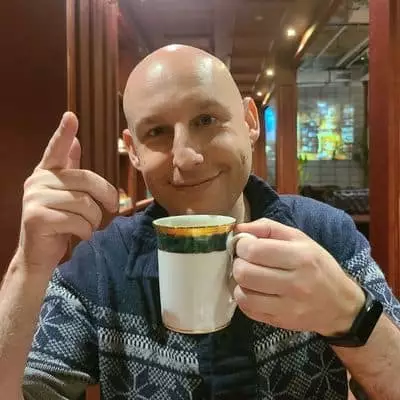Here’s a list of the 50 most amazingly unique Korean experiences that you’ll absolutely want to try when you visit Seoul or other parts of Korea. From dressing up in traditional Korean hanbok and visiting Korean hanok, to sitting down to enjoy ramyeon noodles and watching the cherry blossoms, there are many novel ways to spend your time in Korea and unique places to visit.
Do you want to recreate famous scenes from your favourite K-drama or K-movie, dressing up and snapping pics like a star? Or do you want to dance under the Gangnam Style statue whilst munching mouthwatering Korean street food? In this list of the 50 unique Korean experiences, you’ll find out loads of great ideas that you can do in all seasons and across Korea. You’ll definitely want to use these ideas to create your own South Korean bucket list.
Whilst you might be familiar with some of these, there’s hopefully a lot of unique Korean experiences that you’ve never heard of our considered before. I’m sure you’ll find something fun that you’ll want to try out as soon as you’re in Korea.
Affiliate Disclaimer: This site contains affiliate links and I may earn commission for purchases made after clicking these links.
Guide To These Unique Korean Experiences
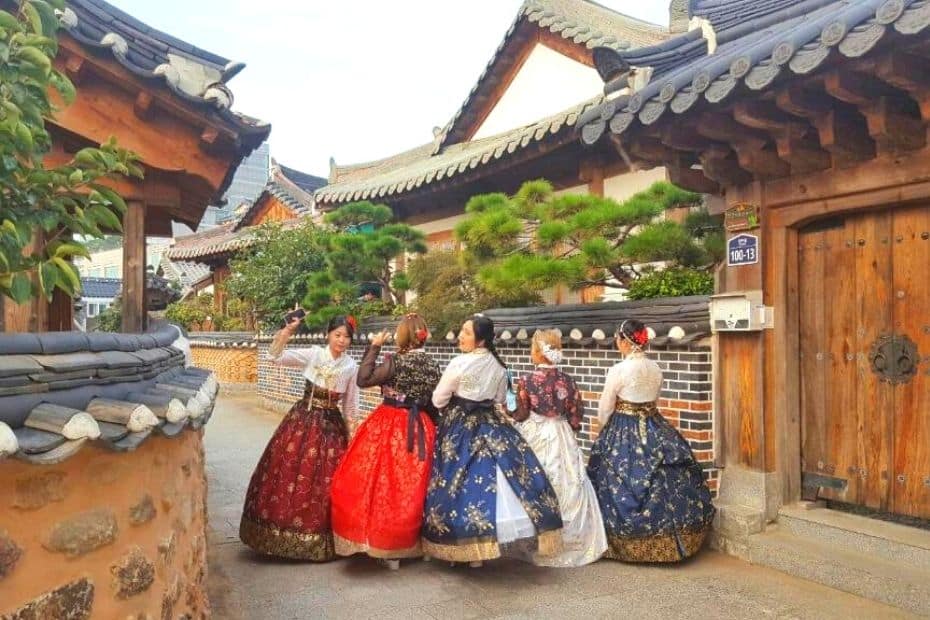
These unique Korean experiences are all things you can do only in Korea, or at least only in a Korean way. Seeing cherry blossoms might be available in many countries, but the way Korea celebrates their oncoming can be unique.
I’ve included links to explain more about each experience or to book online (when appropriate). Booking online helps to avoid crowds and can save money. I’ve also added some links to other articles that I’ve written about travelling in Korea and these unique Korean experiences. They’ll give you a much deeper insight into how, why, and when to enjoy these activities.
Quick links: Looking for a certain type of unique Korean experience? Use the links below to jump straight to the section that interests you, or keep on reading to discover all of the wonderfully unique things to do in Korea.
Planning to visit Korea? These travel essentials will help you plan your trip, get the best deals, and save you time and money before and during your Korean adventure.
Visas & K-ETA: Some travellers to Korea need a Tourist Visa, but most can travel with a Korean Electronic Travel Authorisation (K-ETA). Currently 22 Countries don’t need either one.
How To Stay Connected: Pre-order a Korean Sim Card or a WiFi Router to collect on-arrival at Incheon Airport (desks open 24-hours). Alternatively, download a Korean eSIM for you travels.
Where To Stay: For Seoul, I recommend Myeongdong (convenient), Hongdae (cool culture) or Gangnam (shopping). For Busan, Haeundae (Beach) or Seomyeon (Downtown).
Incheon Airport To Seoul: Take the Airport Express (AREX) to Seoul Station or a Limo Bus across Seoul. Book an Incheon Airport Private Transfer and relax to or from the airport.
Korean Tour Operators: Tour companies that have a big presence in Korea include Klook, Trazy, Viator, and Get Your Guide. These sites offer discounted entry tickets for top attractions.
Seoul City Passes: Visit Seoul’s top attractions for free with a Discover Seoul Pass or Go City Seoul Pass. These passes are great for families and couples visiting Seoul – you can save lots.
How To Get Around: For public transport, grab a T-Money Card. Save money on Korea’s high speed trains with a Korea Rail Pass. To see more of Korea, there are many Rental Car Options.
Travel Money: Use money exchanges near Myeongdong and Hongdae subway stations for the best exchange rates. Order a Wise Card or WOWPASS to pay by card across Korea.
Flights To Korea: I use flight comparison sites such as Expedia and Skyscanner to find the best flights to Korea from any country. Air Asia is a good option for budget flights from Asia.
How To Learn Korean: The language course from 90 Day Korean or Korean Class 101 both have well-structured lessons and lots of useful resources to help you learn Korean.
Top 12 Unique Experiences In Seoul
Travellers to Seoul have a world of unique experiences awaiting them, from incredible sights in Seoul’s distinctive landmarks, to cultural encounters both modern and traditional. Seoul is perhaps the best place to embrace the kind of experiences you can only find in Korea as it’s been a melting pot of history, culture, nature, and people and the centre of Korean life for centuries.
I’ve not included some of the wonderful activities that you can try in other parts of Korea that you can also find in Seoul, such as wearing hanbok and visiting Korea’s traditional markets. That’s because these are available in various cities across Korea and not exclusively in Seoul.
Here are 12 of the most uniquely Korean experiences and activities you can try in Seoul:
1: Stroll around Seoul’s Royal Palaces
There are 5 beautiful royal palaces for you to explore in Seoul where you can peek into ancient throne rooms, walk through picturesque gardens, and experience the life of an emperor or empress. The 5 royal palaces in Seoul are Gyeongbokgung, Changgyeonggung, Changdeokgung, Deoksugung, and Gyeonghuigung. Gyeongbokgung is the oldest and largest of the temples and one of the most incredible landmarks in Asia that you should definitely check out, although they’re all worth visiting.
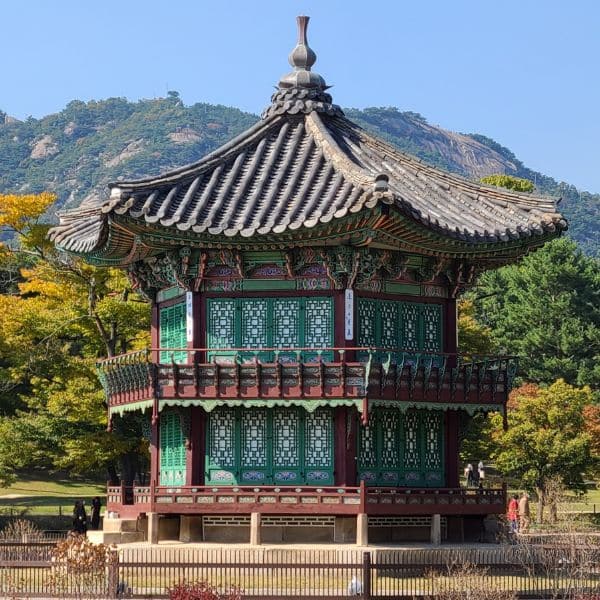
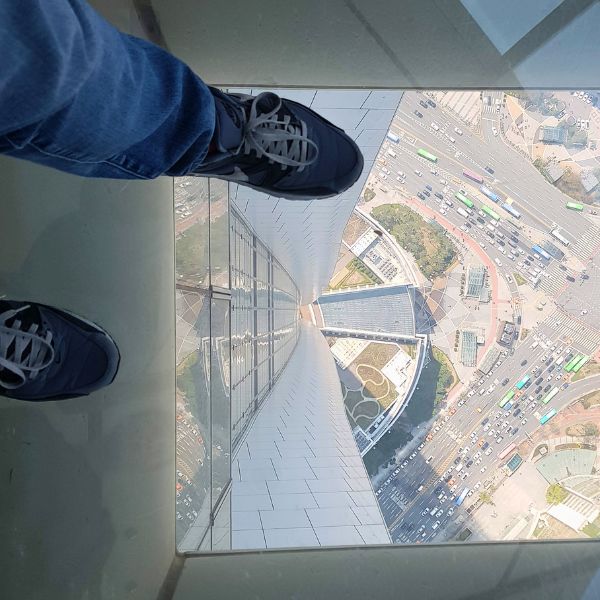
2: Brave The Heights Of The Seoul Sky Observatory
The best place to see Seoul is from the Seoul Sky Observatory on the 120th floor of the Lotte World Tower. The Lotte World Tower, the world’s 6th largest building, points up into the heavens above the glittering waters of Seokchon Lake. Spread over 7 floors, from the 117th to 123rd floor, there are lots of unique things to do here. Are you brave enough to take a selfie on the glass floor? Or even braver to take a walk outside the tower on the Sky Bridge?
3: Learn About Hallyu Culture In Gangnam
Gangnam is home to many places relating to Hallyu 한류 – the Korean cultural wave that has spread around the world through music, movies, TV, and idols. There are loads of attractions in this area to learn about Hallyu, including the K Star Road, the former HQ of entertainment companies, shops, restaurants and cafes owned by K-Pop stars, and the impressive Gangnam Statue dedicated to PSY himself. Certainly the best of these unique experiences in Seoul for K-Pop fans.
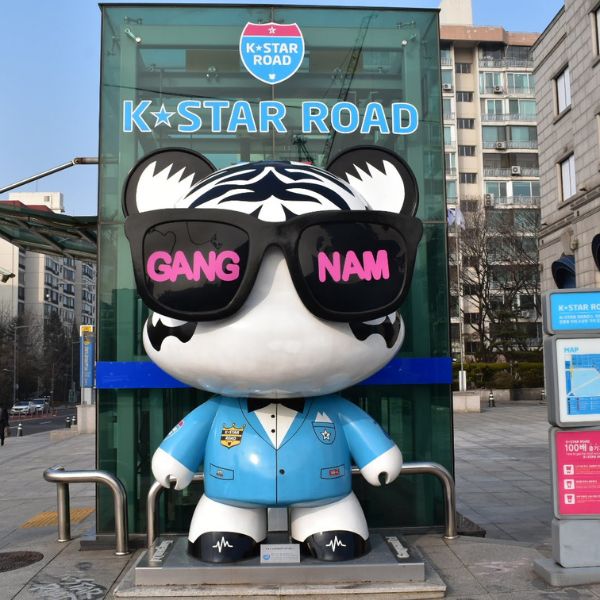
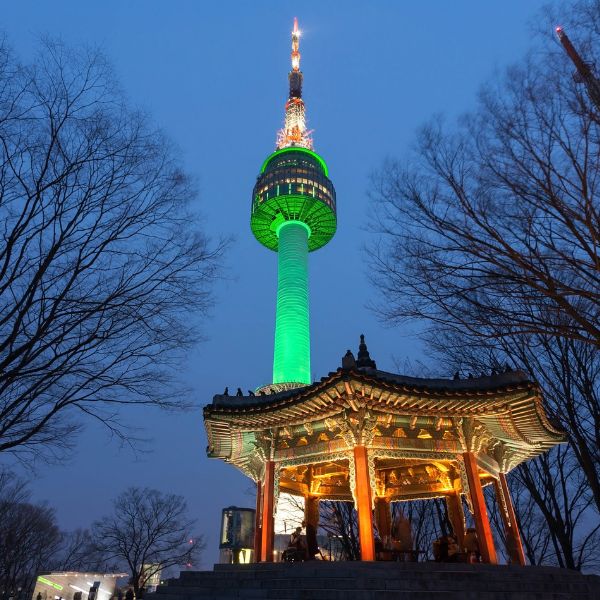
4: See Seoul From The N Seoul Tower
The N Seoul Tower is an iconic location in Seoul, viewable from all around thanks to its location on top of Namsan Mountain in central Seoul. The original date spot in Seoul, this is is a hit with locals and tourists alike and features millions of love locks left by romantic couples from all over the world.
You can get to the N Seoul Tower on foot, hiking up the small hill, but the best way is by the cable car. Once you’re at the top, head to the observatory for lovely 360 degree views of Seoul, including the mountains of Bukhansan National Park.
There are lots of shops, restaurants, and attractions at the N Seoul Tower, too, making this a fun place to explore for an evening.
If you plan to visit many of Seoul’s premium attractions, including the N Seoul Tower and Lotte World, check out this article about the Klook Pass Seoul and how it can save you money in Seoul.
5: Find Fashion, Fun, & Future Trends In Hongdae
Hongdae is arguably the coolest place in Seoul and for many good reasons. Home to big name fashion & discount stores, award winning restaurants, nightclubs, cute cafes, escape rooms, activity cafes, art galleries, and so, so so much more, you can visit Hongdae many times over and never get bored.
My favourite spots (to show tourists) are the Thanks Nature Sheep Cafe, Bau House Dog Cafe, VR & arcade game buildings, Kakao Friends Store, the many wonderful restaurants & craft beer bars, and the stores near Hongik University subway station.
One of the top unique Korean experiences for art lovers, students, and bargain hunters. If you’re after bargain clothes, snacks, souvenirs, or accessories to take home, Hongdae is the place for you.
If you’re planning to visit Korea, I definitely recommend staying in Hongdae. It’s a great place to explore local Korean culture. Here’s 10 Amazing Hotels In Hongdae to stay in.
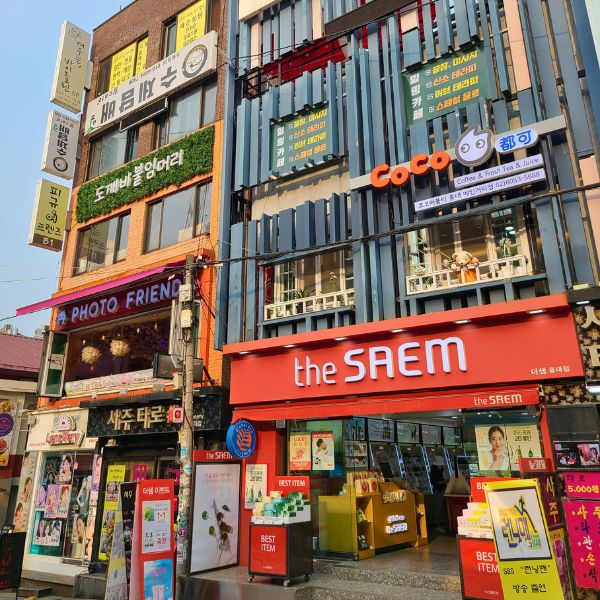
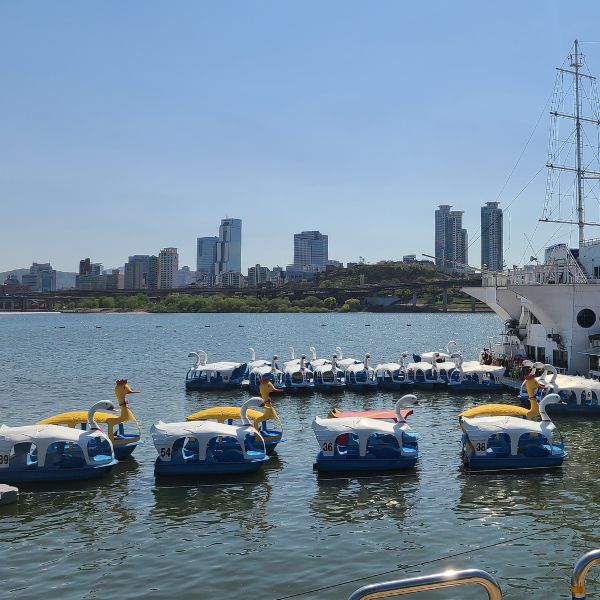
6: Cruise On The Han River & See Seoul’s Sights
Take a cruise along the Han River in Seoul and watch the sunset while the city starts to shine. The river is the perfect places to see the sights of Seoul. You can see the N Seoul Tower, the Olympic Stadium, and the famous Yanghwa Bridge.
You’ll pass by many bridges along the way, but one is more magical than the rest – the Banpo Rainbow Bridge. This bridge was installed with a full spectrum of colourful lights that shine down through jets of water. This creates a stunning rainbow waterfall on the north side of the bridge. The lights are turned on between April and October.
7: Drink A Latte From A Toilet At The Poop Cafe
I don’t know of any other country where poop is treated as something cute, but that’s what you’ll find in Korea. For those that might be a bit squeamish at the idea of a poop cafe, don’t worry. This latte in a mini-toilet is actually pretty cute. The colourful decor is on the theme of, well, poop, and there are little poop hats to wear.
This is a must for those looking for really unique Korean experiences and don’t have a problem taking some really strange pictures for social media. And what could be stranger than a rose (or mint) latte served in a little toilet cup from the Poop Cafe?
Whats more, you can also buy ddong bbang 똥빵 (literally translated to poop bread) and curry served in a traditional style Korean toilet. Gross? Maybe, but definitely memorable!

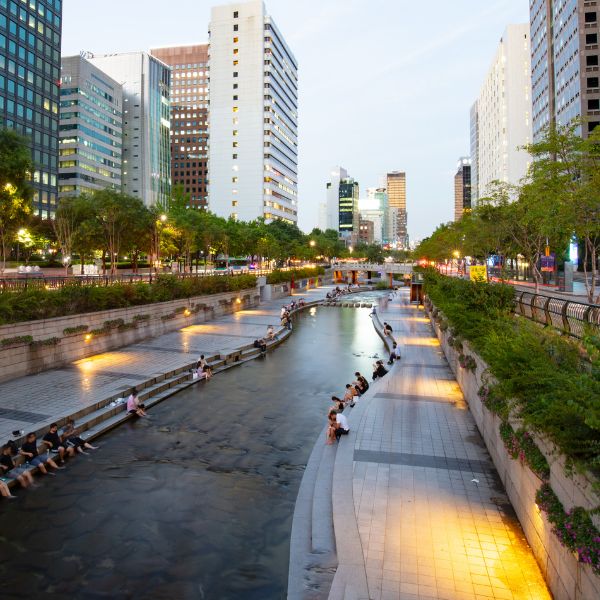
8: Stroll Along The Cheonggyechon Stream
Another great place to escape the summer heat and enjoy something uniquely Korean, is a trip to the Cheonggyecheon Stream in central Seoul. The Cheonggyecheon Stream was created as a place for gathering, harmony, peace, and unity, giving Seoulites a place to come and cool off in the summer heat and to walk together away from the concrete jungle.
For tourists, this is a wonderful chance to experience the light and lantern festivals that often occur along the stream, as well as take a break to hop over the stepping stones and get some colourful photos. The start area, Cheonggye Plaza, usually has events for tourists, including hands-on activities to learn about Korean culture and history.
9: Learn About Korean History – Past & Present
Located in the Yongsan area of central Seoul, the War Memorial of Korea and National Museum of Korea are must-sees for history enthusiasts. It’s also great for those who simply want to know more about the often tragic, always enthralling history of Korea.
The War Memorial of Korea puts a focus on visual, realistic imagery and uses provocative models to bring the horror of war to life. Learn about the role of war in Korean society and conflicts with their bigger neighbours, Japan and China.
The National Museum of Korea completes the history lesson. See the various kingdoms that made up Korea in the past. Marvel at the wide range of artefacts on display, dating from the stone age to now. Finally, learn more about Korean culture through the ages and the contributions Korea has made to the world.
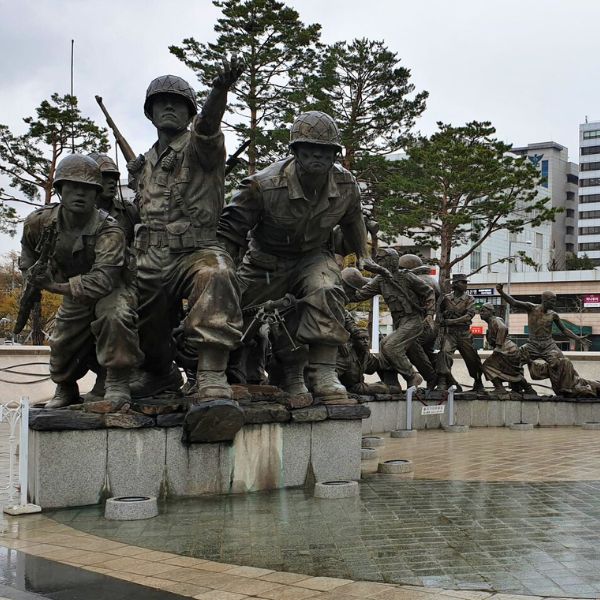
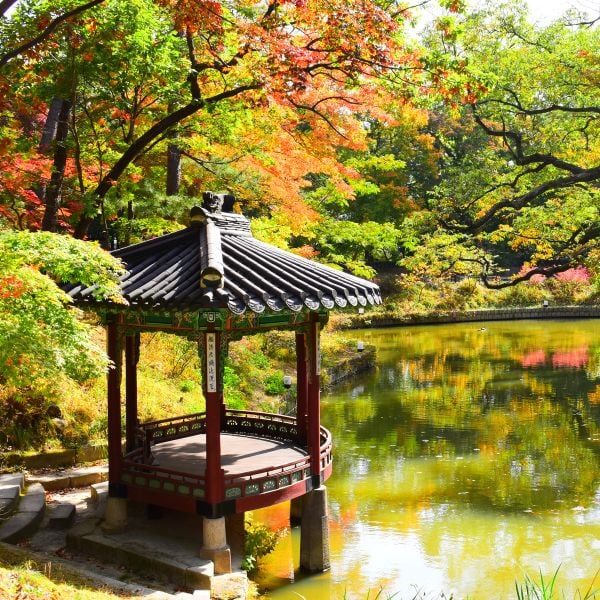
10: Explore The Secret Garden Hidden For Centuries
Hidden away in the wide grounds of Changdeokgung Palace is a real treasure that only a limited number of people get to enjoy each day – The Secret Garden.
The Secret Garden, also known as Huwon or Biwon, takes up a large chunk of the palace grounds, and was originally an area reserved fro the Korean royal family to rest and relax. The area features iconic scenes, such as the pond shaped like Korea (pictured above), beautiful pagodas, and other historic buildings.
The real attraction is the nature on show, with cherry blossoms and autumn leaves coming to life throughout the year, and an abundance of other plants, trees, and even wild animals.
Unlike the other royal palaces, The Secret Garden is not freely open to visitors. To gain access you must book a tour on that day. Be sure to get there early so you don’t miss out on this unique Korean experience.
11: Eat, Shop, Play In Seoul’s Night Goblin Markets
Seoul’s Bam-Dokkaebi (Night Goblin) Markets are the best thing about summer in Seoul. Found across the city from April until October, these markets provide an opportunity to purchase hand-made items from local artists, watch live performances, and sample freshly cooked food from one of the ubiquitous food trucks.
With the heat still lingering at night during summer, the best way to enjoy the evening is by grabbing a cold beer, strolling through the markets, and listening to the impromptu live music performances, especially near the Han River at the Yeouido Global Night Market. If you’re in Seoul in the summer time, then these markets are a must-visit to see how the locals spend their evenings.
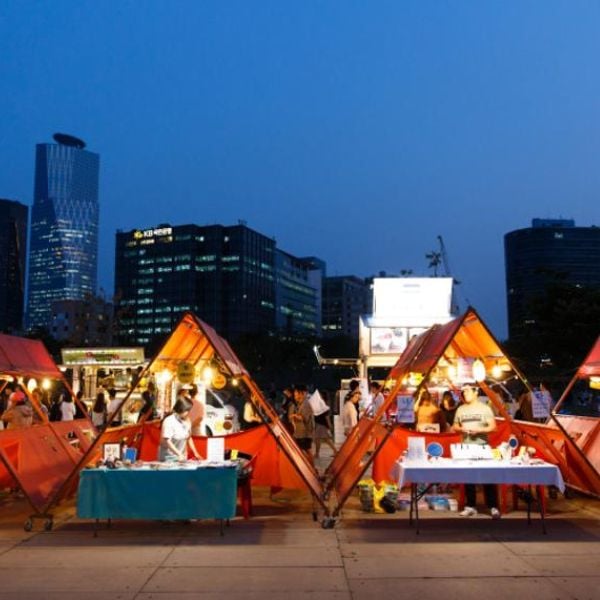
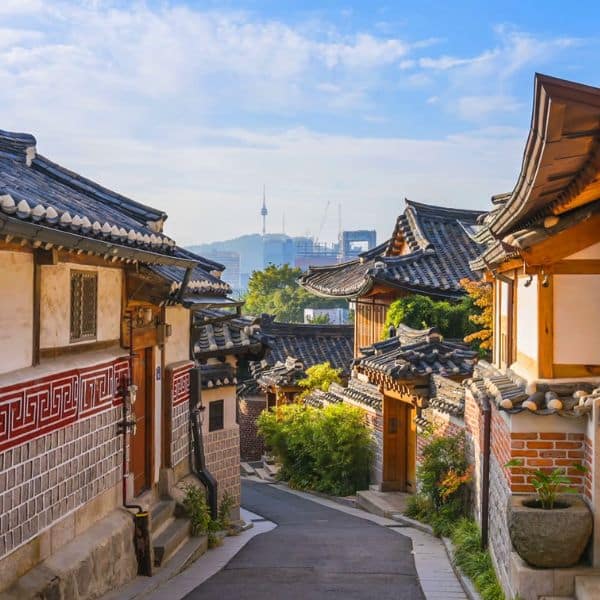
12: View The Streets Of Bukchon Hanok Village
Bukchon Hanok Village is a little piece of history tucked away in central Seoul, between two royal palaces. It’s the perfect place to see traditional style Korean houses – hanok. The area is packed with beautifully preserved hanok buildings where you can pose for pictures, pop your head inside, explore small galleries, sit and enjoy some Korean tea, and lots more.
You’ll probably recognise this area if you’ve seen pictures of Seoul, it’s one of the best places to see traditional Korean buildings, and you get an awesome view of the N Seoul Tower, royal palaces, and Myeongdong as a background. This should really be on your South Korea bucket list if it’s your first time to Seoul and don’t forget to rent some hanbok when you visit, too.
Unique Korean Experiences And Activities
Korea is much more than just Seoul and when you venture outside of the capital, you’ll discover a wealth of unique Korean experiences and activities to enjoy. Of course, many of these are available in Seoul, but you might find better places to sample these Korean delights in other cities, such as Busan or Gyeongju, or in the great Korean countryside and many national parks.
Here are 12 of the most uniquely Korean experiences and activities you can try across Korea:
1: Dress Up In Traditional Korean Hanbok
What could be a more unique Korean experience than dressing up in gorgeous Korean hanbok (traditional Korean clothes)? Available for both men and women, these traditional clothes come in a range of colours with lots of extra accessories and hair styling available.
The best place to Experience Wearing Korean Hanbok is in central Seoul, whilst you’re exploring Seoul’s royal palaces or Bukchon Hanok Village. You can also try this unique Korean experience in Jeonju Hanok Village outside of Seoul and in similar places.
Don’t miss out on the chance to snap some unforgettable pics of yourself dressed up as a Korean lord or lady when you visit Korea.
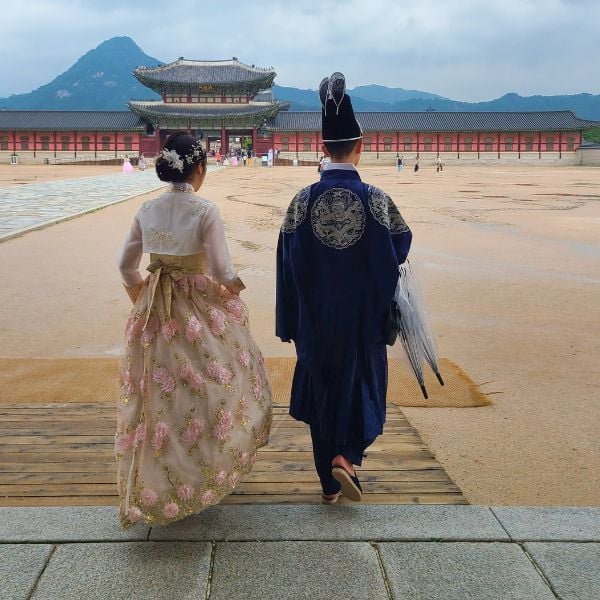
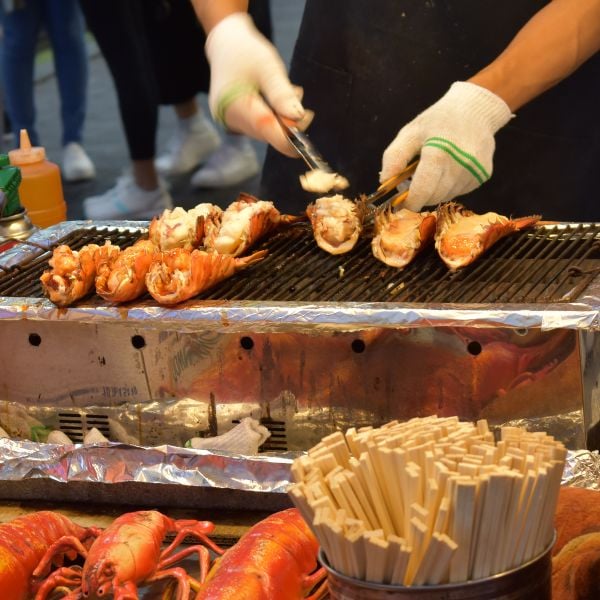
2: Eat Delicious Korean Street Food
One that’s certainly on most people’s South Korea bucket lists is trying out the amazing street food on offer at markets across the country. From spicy tteokbokki to sweet hotteok, or even finger licking KFC (Korean fried chicken), Korea’s markets have an incredible array of tastes, smells, and culinary options for you to try out.
The best news is that Korean Street Food is cheap, so you can sample all of them! For the most authentic Korean street food experience, head to Gwangjang Market in Seoul – you might recognise it from the Netflix show about street food. Definitely try bindaetteok from the food stalls here.
You can find street food in all cities across Korea, each providing some special dishes that are unique to the area. Be sure to try as much as you can when you explore Korea.
3: Stay Overnight In A Traditional Hanok House
What could be more of a unique Korean experience than spending a night in a Traditional Korean Hanok House? Sleeping amongst old wooden walls, feeling the heat through the ondul underfloor heating, sipping tea on polished floors served in the traditional Korean way, and taking in all the intricate decorations on walls, furniture, and fabrics.
You can experience this for yourself during your trip to Korea in places such as the Bukchon Hanok Village, Jeonju Hanok Village, and several other places with hanok buildings that have been carefully converted into hotels. This type of accommodation is open to all visitors, with hanok stays ranging from cheap-sleeps on a futon to more luxurious conditions and 5 star service.
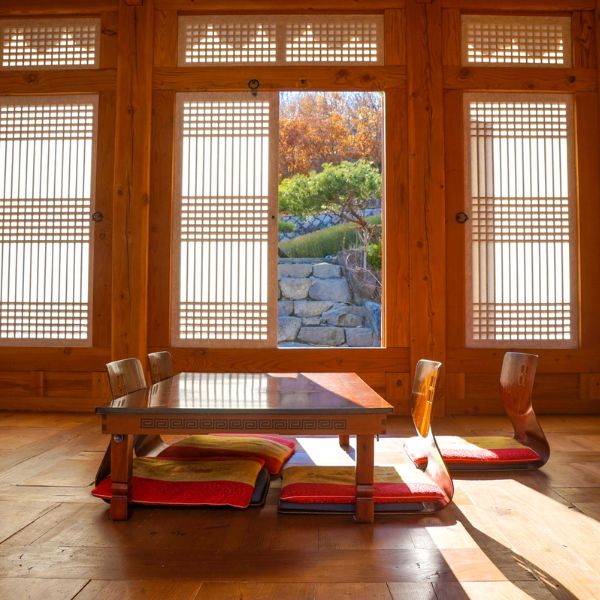
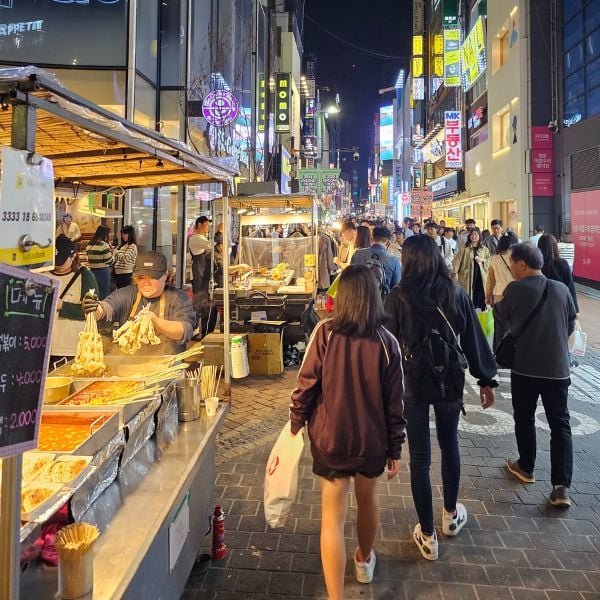
4: Grab Some Bargains At Traditional Markets
Shopaholics looking for the best bargains have so many options available to them in Korea’s traditional markets. There is a wide range of discounted goods, with everything from knock-off Supreme sweatshirts to bargain brand names and lots more.
Some of the best areas to explore Seoul’s markets are Namdaemun, Myeongdong, and Dongdaemun, which all have large traditional markets. Dongdaemun is the best for clothing and also features wholesalers who can ship internationally, as well as department stores and shopping centres.
Wherever you go, make sure to bargain and get the best deals. If you need an extra suitcase to bring it all back in, you can buy those, too.
5: Find Your Soul At A Korean Buddhist Temple
Going through a long list of South Korea bucket list items can be tiring, physically and mentally. It’s important to take some time out and rediscover your spiritual side as you travel. Where better to do that in one of the peaceful Korean Buddhist temples that are scattered throughout Korea.
Gaze in awe at the traditional architecture – in bright greens, blues, golds, and reds. Learn about a religion and history that you might have had no idea about before. And if you’re lucky, you might make it in time for one of the many festivals and events at the temple, such as Buddha’s Birthday in spring.
For an ultimately unique Korean experience, why not try an overnight temple stay? You can visit the temple, join in the sacred rituals, learn about Korean Buddhism (in a non-preachy way), and witness the daily life of the monks.
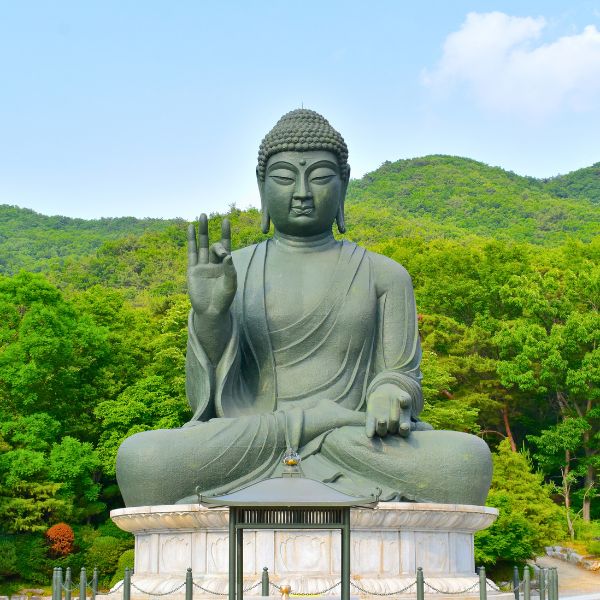
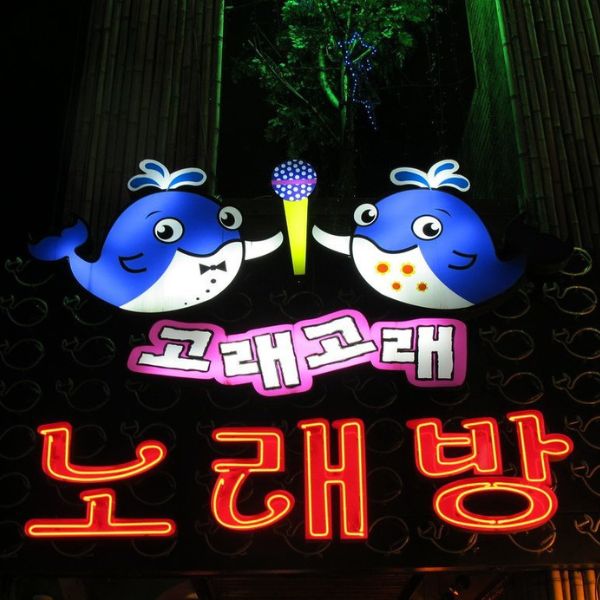
6: Sing Your Heart Out At A Korean Noraebang
Korean people love, love, love to sing. You can’t walk around a city of any size in Korea without bumping into a noraebang (노래방) – a Korean singing room. Noraebangs are designed to let you sing your heart out with a few beers whilst enjoying the disco lighting and fancy wigs they offer. Music lovers will want this on their South Korea bucket list.
If you’re travelling with some friends then check out the singing rooms. You can order drinks and pay a small fee to sing for as many hours as you’d like. Travelling alone but still want to sing? No problem, just find one of the individual singing booths (like a large photo booth). Belt out your favourite K Pop, love songs, or teary ballads.
7: Relax & Unwind At A Korean Sauna
Life in Korea is hectic and there’s nothing better than soaking in a hot pool after a long day. Tired from rushing around ticking off your South Korea bucket list, why not stay at a jjimjjilbang 찜질방(Korean sauna)? Here you can let the stress and tiredness wash off your body.
These indoor hot springs have something for everyone, from steaming saunas to a freezing cold pool and everything in between. You can even sleep in a rest area with free pyjamas provided for you. Jjimjjilbangs also act as cheap overnight accommodation or emergency hotel rooms when you’re stuck without somewhere to stay.
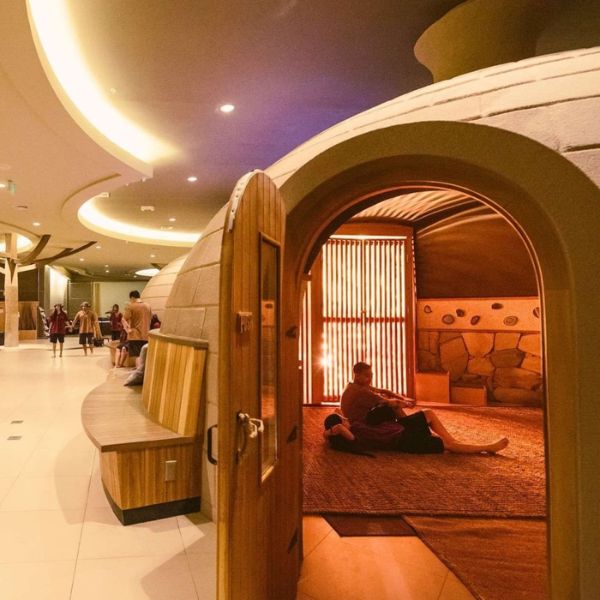
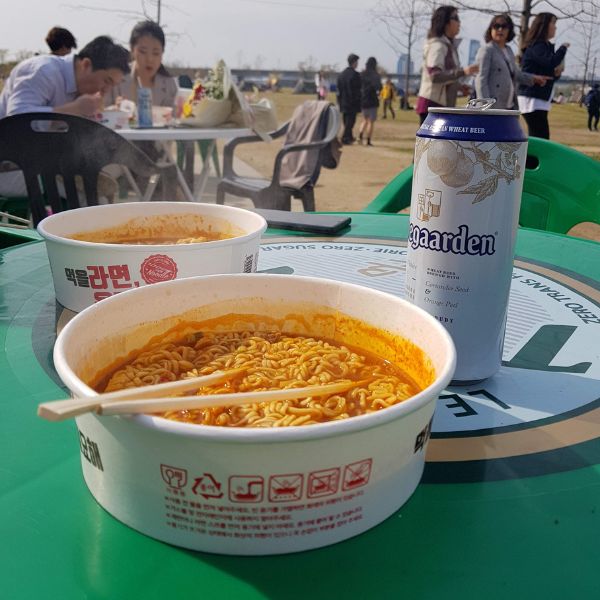
8: Enjoy Beer & Ramyeon By The Han River
Summer In Korea is hot and although it’s not the best time to visit, there are some incredible unique Korean experiences you can discover at this time. The one enjoyed by many Seoulites (and me) is heading to the Han River, grabbing a cold beer and some ramyeon noodles, and taking in the riverside culture that springs up in summer – boarders, musicians, markets, games, and more.
Go to Yeouinaru Station and head to the Han River and you’ll find shops selling various flavours of ramyeon with automatic cookers that will prepare everything for you at the touch of a button. Grab a can of Cass, find a table or spot of grass, and enjoy. You can even rent a tent and make an afternoon of it, watching the sun set and the many lights of Seoul spark on.
9: Unwind With A Traditional Korean Tea Ceremony
Tea is a core part of Korean culture and a good tea room can be a welcome respite for busy tourists and locals alike. Traditional tea houses offer the chance to try fresh green tea from tea fields across Korea, or sample something a bit more unique, such as tea made from rose, persimmon, bamboo, or even mugwort.
Enjoy the tea in a traditional hanok building with peaceful surroundings and calm interiors that will help you unwind. Remember to take off your shoes before you enter, try not to make too much noise, and drink slowly in small sips. Let the tea sit in your mouth for a while before swallowing it and wait as it refreshes your body and soul.
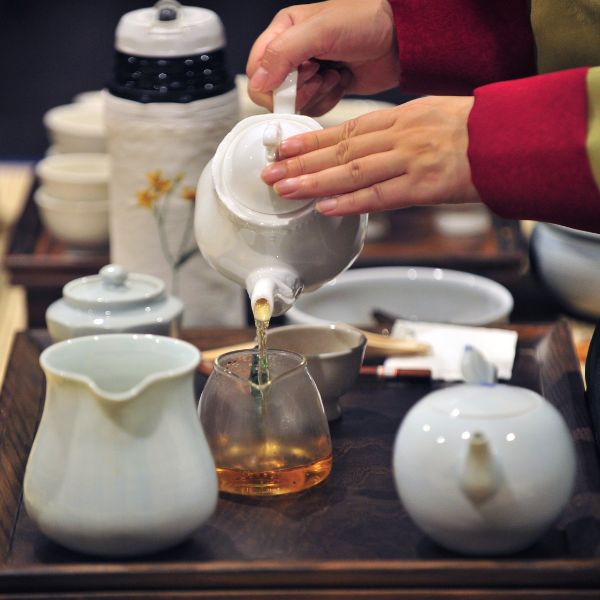
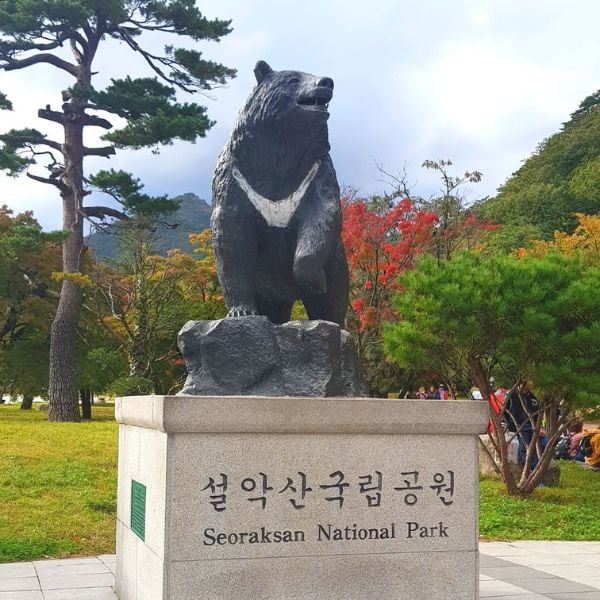
10: Hike Korea’s National Parks & Watch Out For Bears
The last of these unique Korean experiences is one of my favourites and one enjoyed by millions of Koreans each week – Hiking In Korea. Korea is 70% mountainous and has 17 national parks and thousands of interesting mountains to hike.
Some of them are even home to Korea’s black bears and other wildlife, including wild boars, deers, and tigers (actually, they died out a long time ago).
There is a hiking path for everyone in Korea, ranging from gentle walks along the valley floor, to sweating it out climbing over rocks and taking in the incredible views at the peak. Some mountains have cable cars to help you to the top, where you’ll be rewarded with amazing sunset views and, in winter, snowy scenes to take your breath away.
11: Make Traditional Korean Paper Crafts In Jeonju
Discover Korea’s artistic heritage in Jeonju with a papercrafting workshop. Hanji, traditional Korean handmade paper, has been produced for centuries from the bark of mulberry trees. At the Jeonju Hanji Center, learn how to craft beautiful and functional items from flower vases to lanterns using natural dyes and pressed flower petals. Guide your coloured paper into delicate shapes under the instruction of artisans preserving these historic paper making techniques. Getting hands-on with this slow craft is a calming, creative way to connect to Korea’s culture.
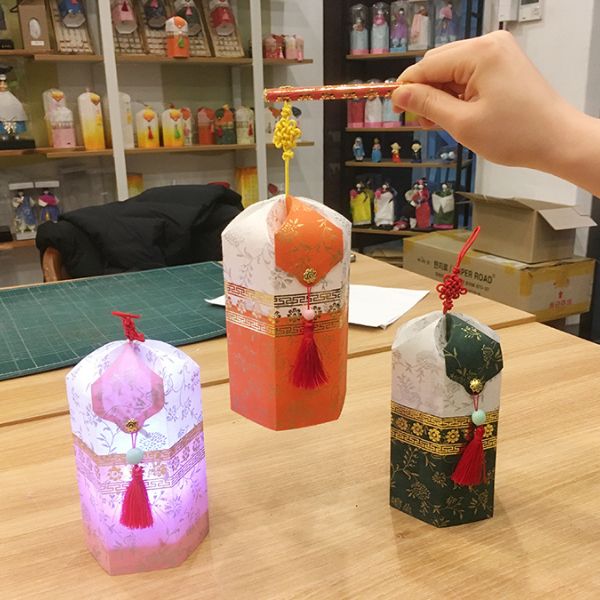

12: Visit Famous K-Culture Sights
There’s a whole world of K-Cultural sights to explore outside of Seoul, from famous K-pop filming spots to epic K-Drama locations. Visit Nami Island to see locations from Winter Sonata, then head to the east coast and visit Daepohang Lighthouse in Sokcho (Strong Woman Do Bong Soon), Jumunjin Beach in Gangneung (Goblin) and for BTS fans, make sure to visit the BTS Bus Stop also in Gangneung.
Further afield, you can see familiar music video backgrounds at Jeju Island’s Seongsan Ilchulbong (The Blue Night of Jeju Island by Soyou) and Jungmun Saekdal Beach (Alcohol-Free by Twice), as well as scenes from Crash Landing on You in Hallasan National Park. In Busan, visit Dadaepo Beach (The King: Eternal Monarch) and the Hansung Apartment Building (Fight for My Way).
Unique Places In Korea To Visit
It’s not only unique experiences that you can enjoy in Korea, there are also loads of interesting, eye-opening sights to discover in the Land of Morning Calm. From war zones to areas of natural beauty, these places while leave you speechless and introduce you to more of Korea’s unique history, culture, and nature. Make sure to bring your camera as you won’t see these elsewhere.
Here are 15 of the most unique places to visit across Korea:
1: See The Most Dangerous Border In The World At The DMZ
South Korea and North Korea are technically still at war, despite recent attempts to finally bring peace to the peninsula. Separating these two countries, and dividing the Korean people, is the De-militarised Zone (AKA the DMZ), lined with landmines, outposts, and thousands of soldiers.
Fortunately, it’s not that dangerous most of the time, which means you can go and see it for yourself while travelling to Seoul. DMZ tours will take you to several famous sights from the ongoing Korean war, as well as allow you to access the Panmunjom ‘Peace Village’ – an area on the border between the north and south.
In Panmunjom you can have what is undeniably a unique Korean experience – you can walk into North Korea and pose with Korean soldiers from both sides. *Please note that tours to Panmunjom are currently unavailable but should be back in the future.
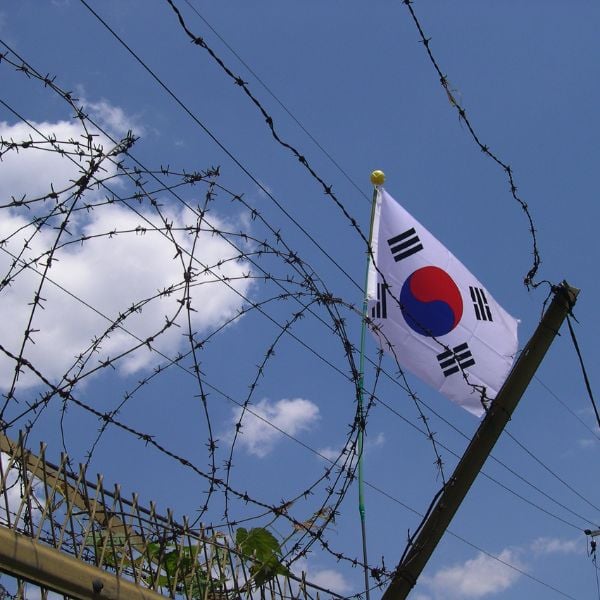
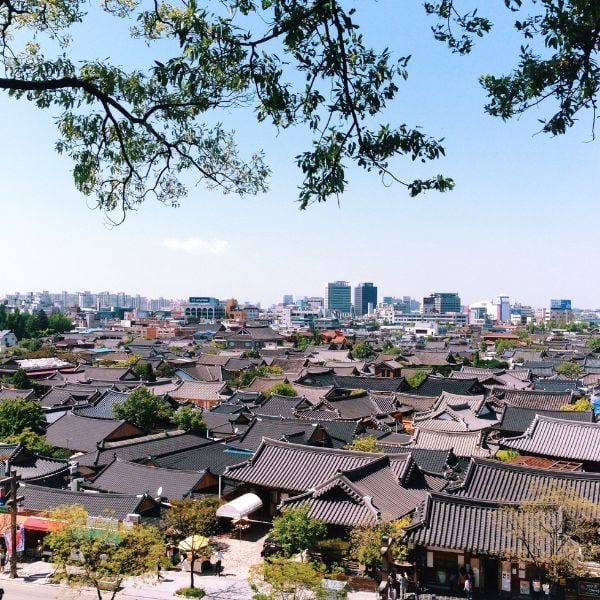
2: Experience Traditional Culture At The Jeonju Hanok Village
Jeonju Hanok Village in central Jeonju beautifully demonstrates life in a traditional Korean setting, with hundreds of hanok (traditional Korean) buildings, shops, cultural experiences, and delicious traditional foods – including Jeonju’s own famous dish, bibimbap. It’s one of those unique Korean experiences that shows you how people used to live, play, eat, and enjoy life.
It’s certainly not a museum, however. You get to be part of the experience, joining in traditional activities at the Jeonju Crafts Exhibition Hall, playing Korean games, dressing up in traditional Korean hanbok, and sitting on the smooth wooden floors of the hanok buildings whilst you eat. You can even stay overnight and see how people used to (and still do) sleep on the floor with futons and underground heating.
3: Get Back To Nature At Nami Island & Garden Of Morning Calm
A short journey from Seoul, Nami Island is a natural wonder that’s amazing year round and has many beautiful attractions to discover. See the giant metasequoia, golden ginkgo trees, as well as cherry blossoms, pines, and many other natural wonders.
Explore the many tree-lined paths, one of which was a filming location for the hit Korean drama Winter Sonata. There are also traditional markets, cultural performances and local foods to try.
Nami Island is the perfect getaway for families, couples, and those looking for some tranquil peace. Nami Island caters for the adventurous, too. You can enter the park on the Nami Island zip line and there are other water-sports nearby. Getting To Nami Island is easy, with public transport or tour options available.
The Garden of Morning Calm is one of the most beautifully sculpted (and most popular) natural attractions to visit near Seoul. Created by a horticultural professor in 1996, the garden is world-class and provides a place to experience the calm and peace that symbolises Korea – also known as the Land of Morning Calm.
You’ll certainly feel calm as you stroll through, smell the flowers, cross wooden swing bridges, see inside traditional Korean houses, or stop for a snack by one of the many streams or ponds. Perfect in all four seasons, this place offers breathtaking walks through dreamy gardens with pagodas, stepping stones, lakes, and an abundance of native and foreign flowers.
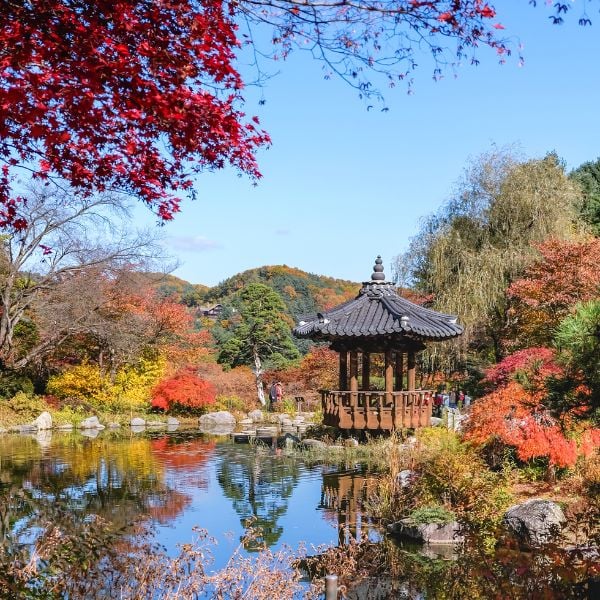
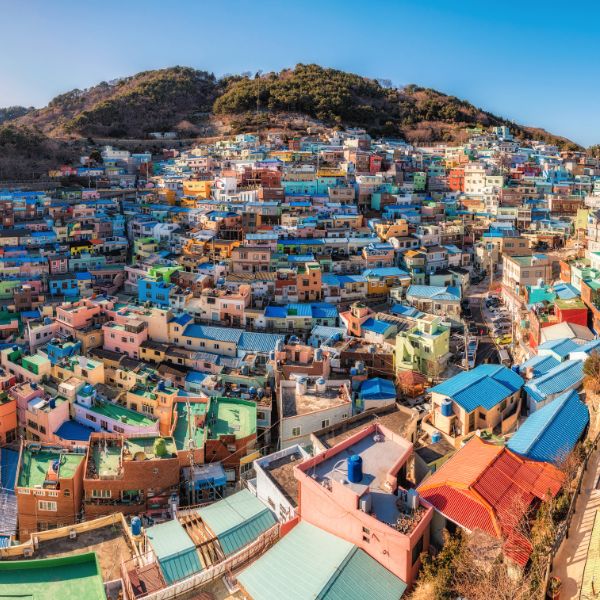
4: See The Views Of Gamcheon Culture Village In Busan
Known as the Machu Picchu of Korea, Gamcheon Culture Village in Busan is high on all photographers’ bucket lists. See hundreds of colourful buildings on the slopes of these coastal hills, as well as murals and sculptures created by local residents. A lot of the art makes use of boring parts of the local landscape and turns them into Instagram-worthy locales.
You can follow the regular street maps, which will show you where to collect stamps along the way. Or get lost in amongst the winding streets, up and down painted stairway murals. There are even cosy little cafes hidden around the place to recover in.
For the best experience, enter via the northern entrance and you’ll find a lot of the most famous sites, including art from The Little Prince, love locks, sock shops, the Library Stairs, and others.
Here are some more ideas for what to do in Busan.
5: Rule The Walls Of Hwaseong Fortress In Suwon
Korea has a history of conflict, with many walls and fortresses needed to protect Korea from their neighbours or factions within the country. One of the best fortress that remains standing if the magnificent Hwaseong Fortress in Suwon and is one of the many fun things to do in Suwon.
This fortress allows you to hike the 6km of walls in a big circuit that cuts through the city, explore the many fortress buildings, and try traditional Korean sports and games, such as archery. This is one of Korea’s UNESCO World Heritage sights and is definitely worth a day trip from Seoul.
There are also beautiful gardens, cosy cafes, and markets near the fortress, as well as the famous Suwon Fried Chicken Street for Korea’s best chicken.
If you’re looking to try some of Seoul’s best chicken joints, then check out the Zen Kimchi Chicken & Beer Tour that runs at night. Experience the best of Seoul’s lesser-known chicken restaurants.
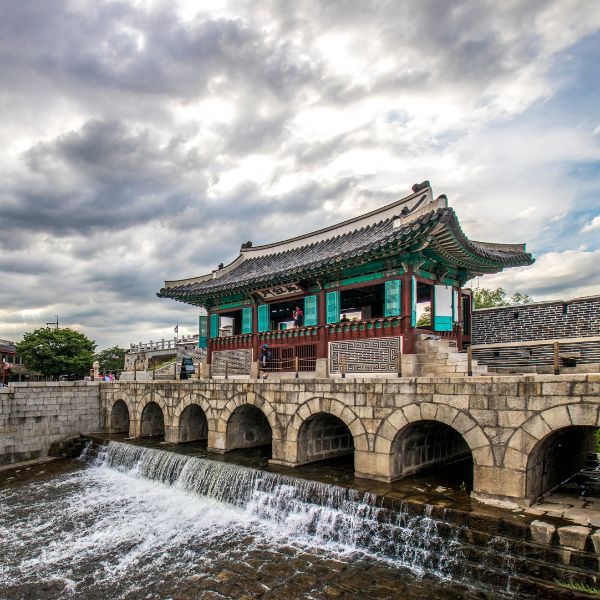
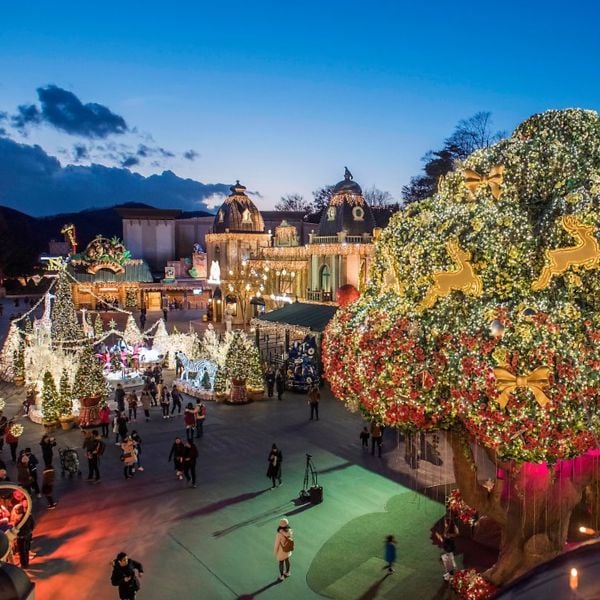
6: Find Thrills In Everland & Caribbean Bay
Korea’s answer to Disney Land or Universal Studios is the thrilling Everland and Caribbean Bay. These are a must for any thrill seeker’s South Korean bucket list.
Everland is Korea’s largest theme park and boasts the world’s steepest roller coaster. This sends you hurtling down to the ground at an angle of 77 degrees and at 104 km/h! Great for thrill seekers, families, couples looking to create some unforgettable memories, and even animal lovers.
Caribbean Bay is one of the world’s largest water parks. With loads of rides, this is the best place to have fun and cool off in summer. Some of the best rides at Caribbean Bay include the Mega Storm, Aqua Loop, and the Tower Raft. Caribbean Bay also features an indoor infant pool, sauna, spa, diving pool, and many types of swimming pools.
7: Gyeongju Historic Area
There’s so many ancient wonders to see in central Gyeongju, the historic capital of the Silla Dynasty from the 7th Century, that the area has been dubbed ‘Korea’s outdoor museum’. The Gyeongju Historic Area encompasses many marvellous creations from the Kingdom, including the 1,400 year old Cheomseongdae Observatory, which has its own special viewing area and light show at night.
The area is a mixture of cultural and natural beauty, featuring bright flower beds, Gyerim Forest, and pink muhly (in October) wrapping themselves around remnants of historic palaces and royal buildings, as well as a confucian school, centuries old statues, and burial mounds. There are many other unique sights in this area, including Woljeonggyo Bridge and the Gyochon Traditional Village.
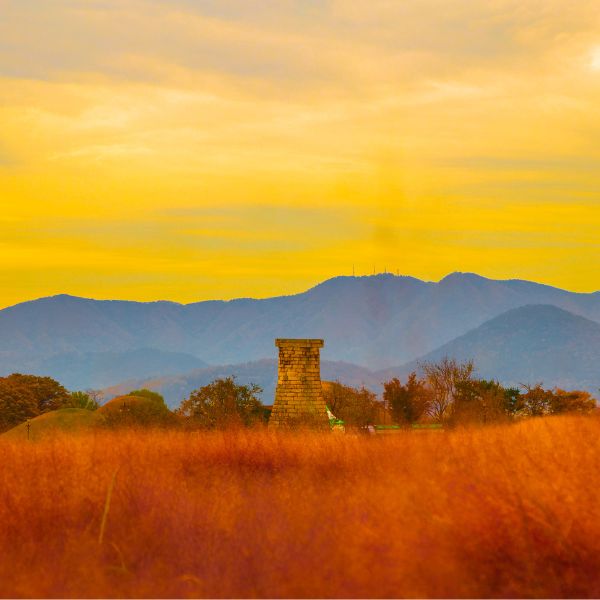
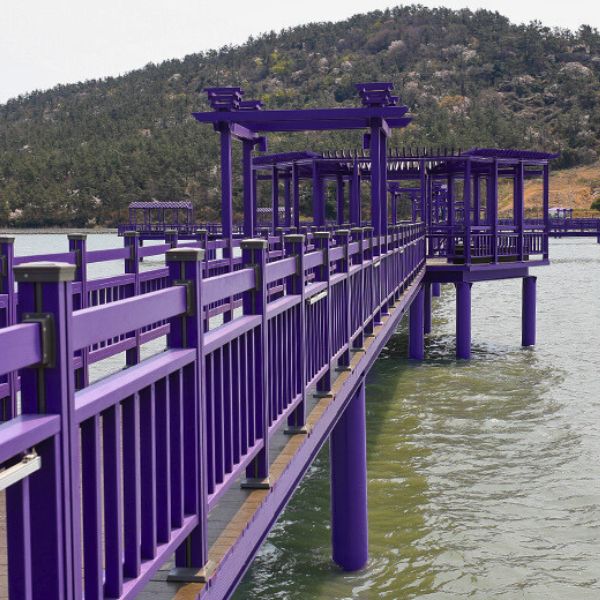
8: Visit The Purple Banwol Island
A former farming town in southern Korea has transformed itself into a insta-worthy attraction by painting everything a lovely shade of lilac. Banwol Island, known as ‘Purple Island‘, really has to be seen to be believed. There are over 400 homes, bridges, and other buildings painted in purple colours, with summer lavender providing even more purple picture opportunities. It’s truly unique.
9: Hike The Jeju Olle Trail
Escape the crowds by lace-up your boots and tackling sections of Jeju Island’s Olle Trail. Stretching over 437km around the island’s coastline and split into 27 courses, this well-maintained route passes through verdant forests, along coastal cliffs and by volcanic craters. The courses are well signposted and you can easily complete at least one course in a day, maybe even two if you are feeling active.
Follow stone pathway markers as you wander quiet backroads, dipping into local villages and stopping at cafes along the way. Choose easy coastal stretches or challenge yourself scrambling over Hallasan’s foothills. With epic landscapes and ocean vistas around every bend, the unique experience of hiking the Olle Trail lets you discover Jeju’s wild beauty. Grab an Olle Trail passport to record your journey, too.


10: See The World’s Highest Lava Column
Ever thought about walking inside the lava tubes formed by a 2km high volcano and seeing the world’s highest lava column? Well, even if you haven’t, you should probably add it to your South Korea bucket list and check it out if you visit Jeju Island – home to South Korea’s largest mountain and active volcano.
At Manjaggul Cave on Jeju Island you can walk along a dark and spooky tunnel created by lava as it violently pushed its way from the depths of the earth out into the seas. You’ll see the where the lava flowed, learn about the island’s history, and at the end see the world’s highest lava column, standing like a frozen rocky waterfall.
11: Visit Coastal Haedong Yonggungsa Temple In Busan
A trip to Haedong Yonggungsa Temple is a rare chance to see the beautiful southern coast and one of the oldest Buddhist temples in Korea. The clear blue seas are on par with what you’ll find in Haeundae Beach. However, when contrasted by the rugged rocks and unique architecture, this is an even more amazing view.
As you make your way from the entrance, you will be amazed by all the sights there are to see. Pass by rows of zodiac statues (can you find yours?), be astounded by the large golden statues of Buddha, and, of course, take lots of pics of the temple itself, like the one above.
Haedong Yonggungsa Temple is one of the three sacred places related to the Goddess of Buddha of South Korea. Its motto is ‘at least one of your wishes will be answered here through sincere prayers‘. Hopefully your wish can come true.


12: Try Green Tea At The Boseong Green Tea Fields
The Boseong Green Tea Fields near Gwangju is the biggest plantation in Korea and setup to welcome curious tourists who wish to learn more about this delicious drink.
The sight of row upon row of fresh, bright tea leaves just waiting to be picked and drowned in hot water is incredible and like a postcard picture. Spend your time walking around the green tea bushes set on the side of lush hills where you might even be able to see the sea on a sunny day.
Other attractions, besides drinking lots of tea, include the Korean Tea Culture Park, the Tea Museum of Korea, and, of course, the gift shop. Korean green tea is refreshing, healthy, and one of the unique Korean experiences you can take home and share with friends and family.
If you’re visiting Jeju Island, you can also see green tea plantations at the O’Sulloc Tea Museum and Green Tea Fields.
13: Get Lost In The Damyang Bamboo Forest
The Bamboo Forests Of Damyang, known as Juknokwon in Korean, provide a unique opportunity to see gigantic bamboo trees. Meander along shaded pathways, experience a traditional Korean village, and try some bamboo beer (better than it sounds). Sample the local delicacy daetong bap (bamboo rice), which is a healthy portion of steamed rice served in a bamboo stem. Yummy.
This lush, dense bamboo forest drowns out the noise and heat of modern Korea and is a breath of fresh air. Quite literally, in fact, as there is a high level of oxygen produced from all those bamboo trees. Take a deep breath and cleanse your lungs and your soul as you walk through the cool forest, perfect for those who want a zen South Korea bucket list.

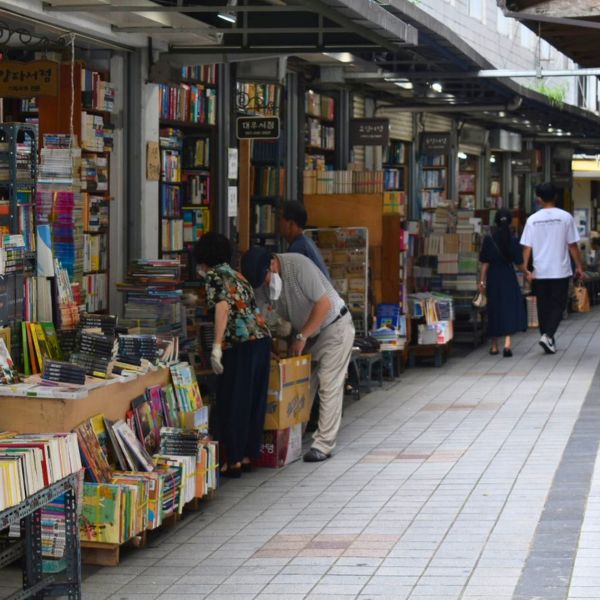
14: Find Rare Books In Bosu-Dong Book Alley In Busan
Book lovers making a South Korea bucket list will love this spot. The quaint Bosu-Dong Book Alley in Busan has books of every kind in a range of different languages. It’s a must for book lovers who want to find something unique and for those who just love being around books. Don’t worry if you can’t understand everything, you can browse freely and take in the atmosphere.
When you get tired of looking at books and squeezing through the narrow street, there are many cafes nestled in or between the book shops. The atmosphere is very different from the rest of Busan and the ambience and charm from this historic, mostly untouched street that has been selling books for over 70 years now is lovely.
15: Get Snap-Happy At The Dreamy Camera Cafe
For those looking to leave the bustling streets of Seoul behind, along with all the other cute cafes and cool hangouts, then why not head out to the Dreamy Camera Cafe in Yangpyeong County. As the name suggests, this is more than just a cafe, it’s a place to dream. Set in the idyllic Korean countryside, the views are astounding, both of the model Rolleiflex Twin Lens Camera building, and the never ending greenery outside.
The friendly owner of the cafe encourages guests to take some time out and enjoy the beautiful natural surroundings whilst pondering their own dreams for the future. Take your time and sample some fresh coffee and one of the delicious cakes on offer while you contemplate. Before you leave, take a minute to write down those dreams. Who knows, maybe you’ll come back again one day and realise that dreams can come true?
Unique Korean Festivals To Experience
Korea is a country steeped in rich and diverse culture and history which is best witnessed through it’s many festivals held throughout they year. Besides beautiful festivals celebration cherry blossoms and autumn leaves, there are unique festivals that you won’t find anywhere else in the world. I’ve chosen one from each season to share below, as well as the amazing cherry blossoms and autumn foliage.
If you plan to visit Korea at a certain time and want to check out festivals during that season, you can find the best ones in my seasonal guides to Korean festivals, which currently includes the best spring festivals in Korea and the best winter festivals in Korea.
Here are some of the most unique Korean festivals you can join in Korea this year:
1: Spring – The Jindo Sea Parting Festival
Like Moses parting the waters, the Jindo Sea Parting Festival is a unique annual occurrence that has to be seen to be believed. Watch as the seas give way and form a 3km-long pathway between islands. You’re not likely to see an event like this elsewhere in the world. This is one of the best of the spring festivals in Korea.
Join the festival and watch as the waters part before your eyes and then trek across the pathway between islands. There are also lots of cultural events and activities going on while you wait for the miracle to occur.
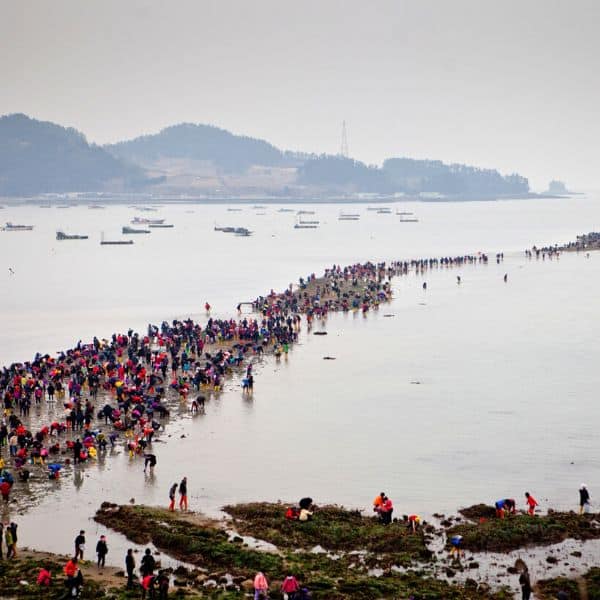
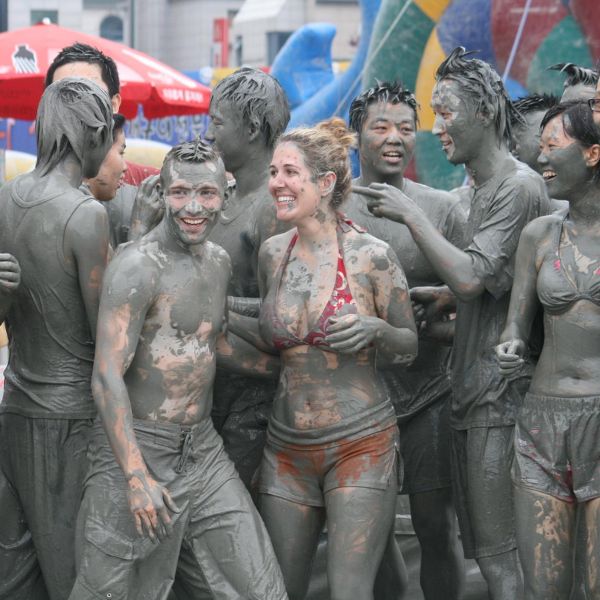
2: Summer – The Boryeong Mud Festival
Don’t mind getting dirty or want to put on an all-body mud pack? Then the Boryeong Mud Festival is the place for you. This festival is one of the wildest in Korea and attracts the largest number of foreign visitors. Running throughout the second half of July, the cool mud is a great way to escape the Korean summer heat.
There are a wide range of activities on offer, including mud face painting, mud beauty products, and the Mudflat Games. The Mudflat Games are what make this festival so unique, with mud wrestling, mud football, and even a mud marathon to compete in.
After spending a busy day in the mud, why not sample some fresh hoe (raw fish) and watch the sparkling sun set into the calm ocean. Spectacular views, good food, healthy mud, and lots of fun – this festival should be high on your South Korean bucket list.
3: Autumn – The Jinju Lantern Festival
With thousands of lanterns on display, including full-sized replicas of buildings and trees, it’s easy to see why the Jinju Namgang Yudeung (Lantern) Festival is the most popular of all the lantern festivals held in Korea. Hundreds of thousands of people attend this two week festival in October.
The most impressive section is along the river and in the Jinjuseong Fortress. The best time to see the lanterns is after the sun goes down, but there’s still a lot to see and do while the sun is up, including cultural displays (dancing) in the fortress, lantern making (various kinds), traditional Korean games, and a lantern contest to judge.

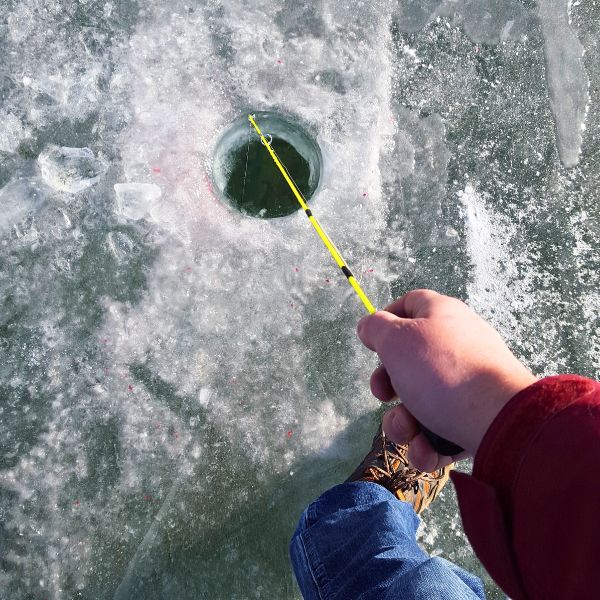
4: Winter – The Hwacheon Ice Fishing Festival
Running for most of January each year, the Hwacheon Ice Fishing Festival is arguably the best winter festival in Korea. During this time you can take part in various winter activities, including ice fishing for sancheoneo (mountain trout), tubing on a giant ice slide, grabbing fish with your bare hands, and even ice sledding.
Those who don’t mind the cold water can join in the barehanded fish catching contest. Catch the one with the golden ring attached and you can win the grand prize! If you’re not really into fish, then check out the ice sculptures, snow sculptures, light displays, and festival food on offer throughout the village. There are several other ice fishing festivals and these unique Korean experiences provide a perfect winter activity to enjoy the snow.
Learn more: I wrote a detailed guide about visiting the Hwacheon Ice Festival during winter and what you can see and do at the festival with details about how to get there.
5: Marvel At The Beautiful Cherry Blossoms
If you’re visiting Korea in spring, seeing the Gorgeous Cherry Blossoms should definitely be on your South Korea bucket list. These pinky-white blossoms adorn millions of trees and Korea has so many wonderful spots to view these harbingers of spring that it’s hard to choose the best place to see them. From royal palaces to national parks, you’ll find cherry blossoms of all kinds across Korea.
Whilst you may associate cherry blossoms with Japan, I’ve included this on the list of unique Korean experiences for the way cherry blossom season is celebrated in Korea. Grab some ramyeon and beer from the nearest convenience store, find a nice spot to sit outside, and devour them whilst appreciating the blossoms – just like many Koreans do each spring.
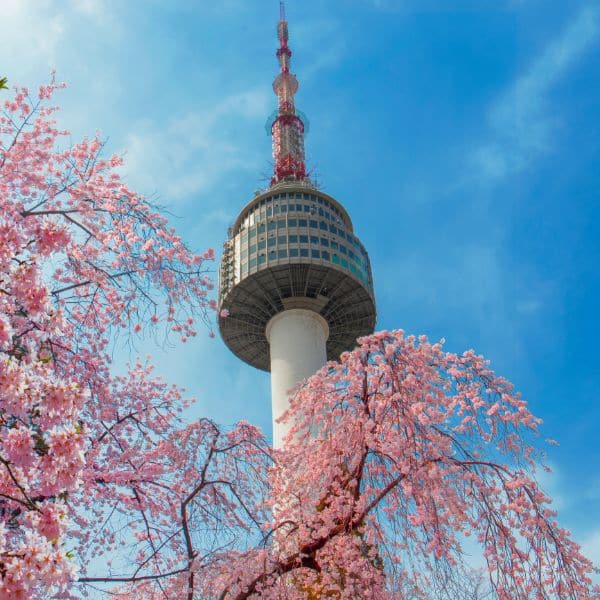
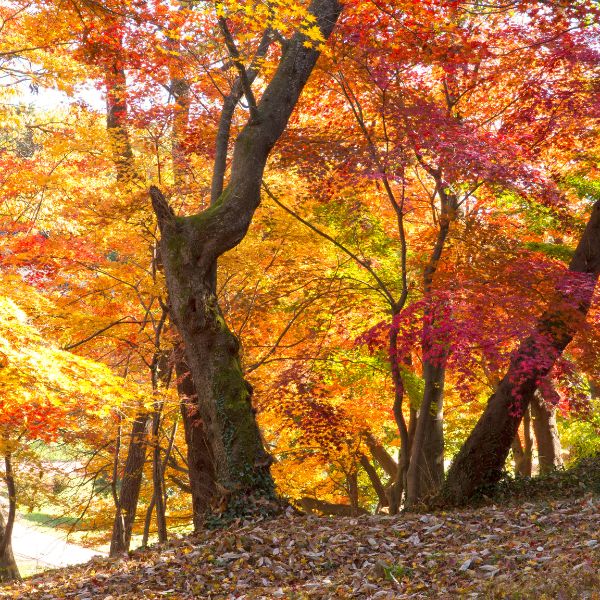
6: Witness Incredible Autumn Foliage In Korea
Few sights rival the brilliance of Korea’s autumn scenery. As crisper air creeps over the peninsula, trees ignite into rich shades of crimson, orange and gold. One of the best places to catch the fall foliage is Seoraksan National Park. Taking the cable car to the mountain’s lofty peak treats you to a bird’s eye view over a patchwork quilt of colour in the valleys below. Meander quiet trails lined with maple trees under a bright blue sky for the quintessential autumn in Korea experience. Time your travel right to stand amid the blazing autumn hues before they fade away.
Unique Korean Foods To Try
Every country has their own national dish and popular foods, and Korea is certainly no different. However, beyond a selection of distinctive dishes, Korea also offers unique food experiences to try out, such as eating your food live, sharing with friends, and making your own meal. There are also meals and drinks that go well in certain situations in Korea, such as after hiking.
Here are some of the best unique Korean food experiences that you can try in Seoul and beyond:
1: Experience Korea’s Best Meal – Korean BBQ
My favourite of these unique Korean foods, and you have to try in Korea, is enjoying a night of Korean BBQ (samgyeopsal). You might think that BBQ is a global thing, but in Korea, eating BBQ is more than just having a meal – it’s an event. A Korean BBQ is a microcosm of Korean culture – it’s about sharing, indulging, letting go whilst thinking of others, and the need to have a good time.
Korean BBQ is a shared meal which often involves a lot of drinking, etiquette rules (that you probably won’t know about), social bonding, and amazing food. Lots and lots of amazing food. If you’re not a fan of pork, you can also try Korean BBQ with beef. Don’t eat meat but don’t want to miss any unique Korean culinary experiences? You can order extra dishes such as naeng-myeon (cold noodles).
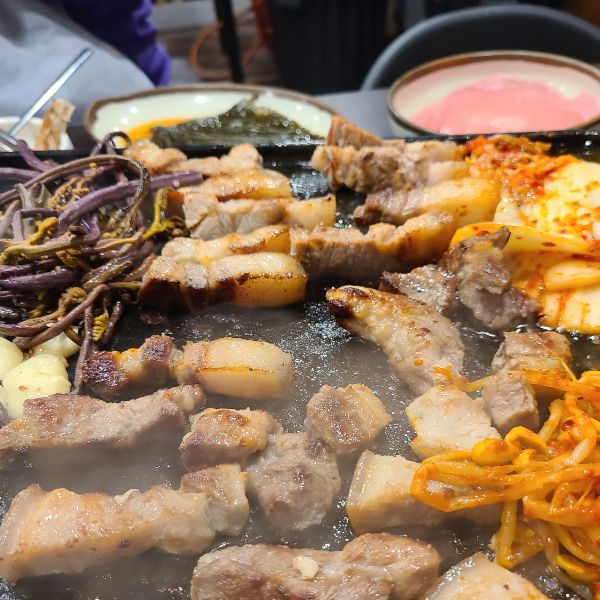
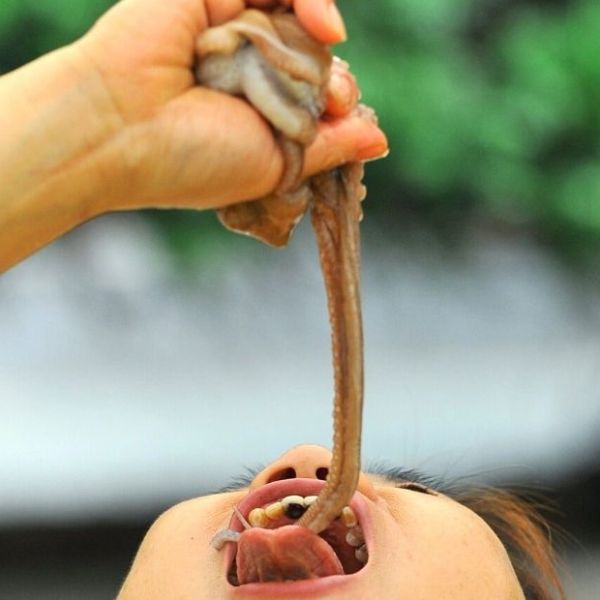
2: Eat Your Food While It’s Alive
If you’ve ever watched the classic Korean movie Old Boy, you’ll know that eating live animals (an octopus in the movie) is something that can happen in Korea. While this might seem cruel, it’s certainly a unique food experience and one you can try if you’re visiting coastal areas in Korea. Besides foods eaten alive, there are also dishes cut up while they’re still alive, such as eel and frogs.
The most common live food to try in Korea is called sannakji (산낙지), which is live octopus legs (not the whole thing). This dish is certainly a weird experience as the suckers are still really strong and you have to tug each leg out of the dish they’re in. Make sure to dip them in sauce to loosen them up. Want to learn about some more unique Korean foods? Check out these weird Korean dishes.
3: Share Korean Pancake With Makgeolli After Hiking
After a busy day hiking in one of Korea’s lovely national parks, the best way to recharge and relax in Korean-style is with the traditional Korean hiker’s meal of jeon (pancake) and makgeolli (Korean rice wine). There are several types of pancakes available, including kimchi pancake, potato pancake, and the most popular one – seafood pancake (hameul pajeon), made with squid and green onions.
What makes this a unique Korean food experience is the sharing culture prevalent in many Korean meals, but this time it’s elevated as you’re sharing the meal with someone who has hiked with you and is just as tired. The feeling of sipping chilled makgeolli from a bronze bowl and tearing off a piece of pancake to dip in the spicy soy sauce is so rewarding and even better when shared with hiking buddies.
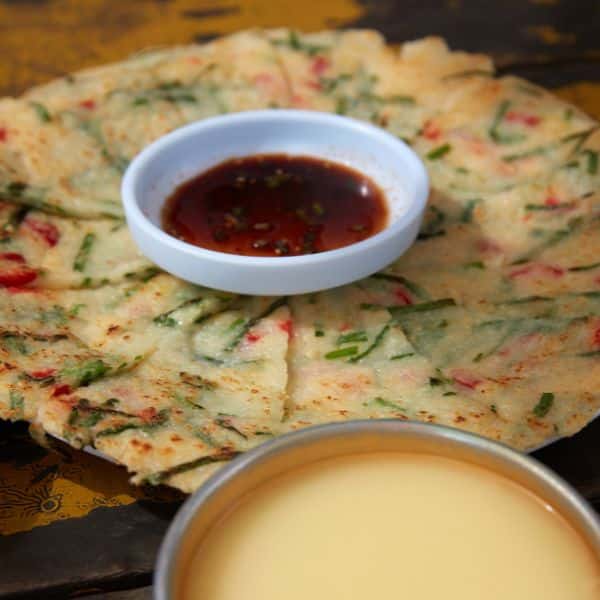
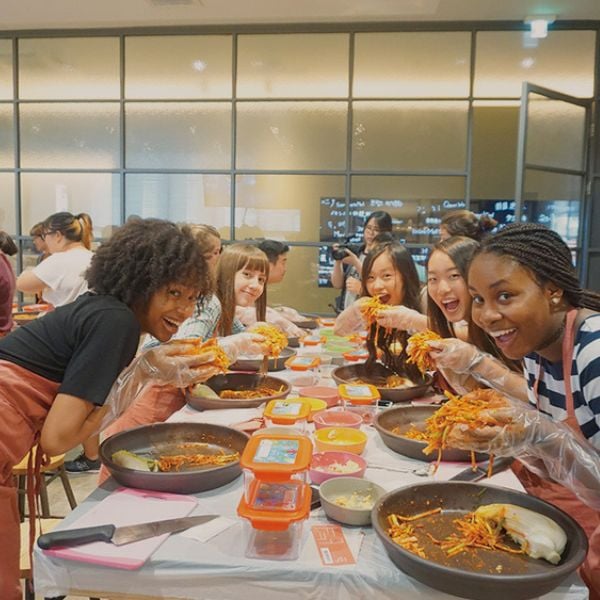
4: Become A Kimchi Expert At The Kimchi Museum
Truly Korean, kimchi is the national dish of Korea and a part of every meal – even breakfast. Kimchi is a fermented Korean side dish that is a bit spicy and salty, but very healthy. It’s made from a range of ingredients, but usually cabbage. You’ll find kimchi in any restaurant you go to and it goes with everything. You can’t say you’ve visited Korea if you haven’t tried at least one type of kimchi.
Koreans spend a whole day at the start of winter making kimchi, which is called kimjang. I’ve tried making kimchi and it’s an interesting insight into Korean food culture. If you want to try it, visit the Museum Kimchikan in Insadong, Seoul. This museum teaches you all about the history, health benefits, and process of kimchi-making. You can also try samples of different kimchi (there are over 200 types).
5: Sample Fresh Seafood At Jagalchi Fish Market
There are many great things to do in Busan, and visiting Jagalchi Fish Market is certainly one of the best. It’s stinky, messy, and full of weird looking sea creatures, but also an experience that shouldn’t be missed. Seeing millions of wriggling sea creatures might seem strange to most, but walk around the busy stalls and you’ll find yourself enthralled with the many fish and seafood on offer.
The best part about visiting this market is the chance to sample the freshly caught seafood offerings. Buy from the open markets on the 1st floor, then wait as they’re cooked (or served raw) for you on the 2nd floor. Even if you don’t like seafood, this place is still worth checking out for unique sights. Keep an eye out for the active market sellers and walk around to find the best bargains.
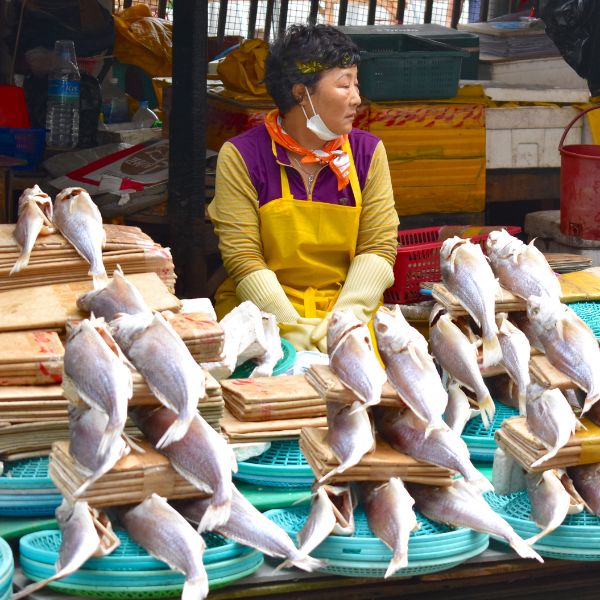
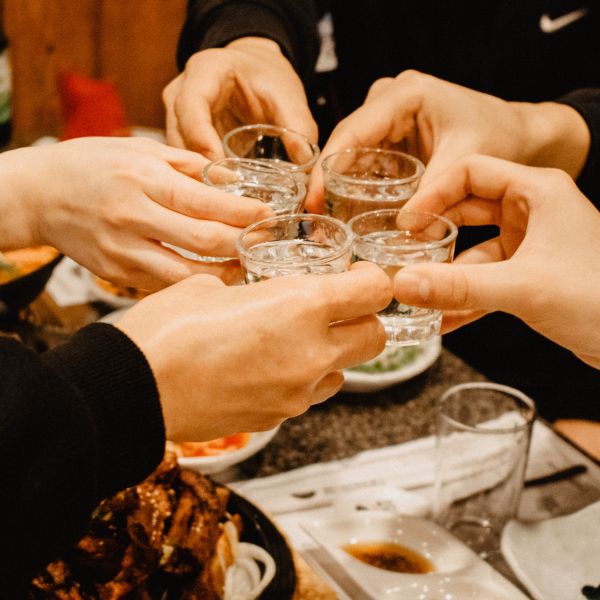
6: Try The Drink That’s Bigger Than Vodka – Soju
When you think of the world’s biggest spirit brand, you probably think of Vodka. Little do most people know that the world’s largest spirit brand is Jinro Soju. Soju is Korea’s national drink and consumed regularly by many Koreans. Being only 14% in strength and costing around 1,800 won (about $1.50) for a bottle in a convenience store, it is easy to see why this drink is so popular.
Soju by itself doesn’t taste of much, but mixing it with Korean been (maekju) makes a drink called so-maek (soju with beer), which vastly improves the taste of the two individual drinks. Of course, if that doesn’t sound sweet enough for you, there is fruit flavoured soju that makes drinking them (and getting drunk) a lot easier! This type of soju is increasingly popular around the world, but best tried in Korea.
Frequently Asked Questions
Here are some frequently asked questions about unique Korean experiences to try in Korea. These answers are based on my own experience and from research conducted to write this article. If you have any more questions about this topic, please feel free to post a comment at the end of this article.
What are the most unique Korean experiences?
The most unique Korean experiences, ones you can’t find outside of Korea, are trying on Korean hanbok, staying in a traditional Korean hanok building, and sampling Korean street food at one of the sprawling traditional markets in Seoul and other cities.
Are there any unique Korean experiences outside Seoul?
Yes, there are many unique Korean experiences that you can’t witness in Seoul, such as doing a temple stay in a national park, visiting one of the many unique festivals, visiting the Boseong Green Tea Fields, and lots of unique experiences that you can find on Jeju Island.
What are some things Korea is famous for?
Korea is famous for many things, including kimchi, hanbok traditional clothes, hanok houses, the royal palaces of Seoul, Jeju Island – one of the New 7 Wonders of Nature, Lotte World Tower – the world’s 6th tallest building, and lots more.
What unique Korean experiences should I not miss?
Don’t miss out on the chance to wear traditional Korean hanbok and visit the traditional hanok villages in Bukchon or Jeonju. Also try some of the unique Korean dishes that are best in Korea, such as BBQ, live octopus, and pajeon.
What unique Korean experiences can I do for free?
There are many unique Korean experiences that you can enjoy for free, such as wearing hanbok (traditional Korean clothes), hiking to the N Seoul Tower, visiting the many Korean Buddhist temples, and even exploring the royal palaces on Culture Day (last Wednesday of each month).
Liked This? Pin It For Others
If you enjoyed reading this article, then please share this with your friends on Pinterest.
